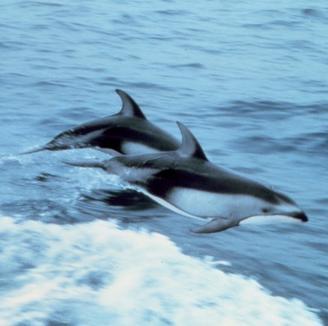Fact File about Dolphins
Type: Aquatic Mammals
Size: 1.2m (4ft) - 9.5m (30ft)
Weight: 40kg (88 lb) - 200 kg (The Orca is 10 tonnes)
Habitat: Worldwide, mostly in the shallower seas of the continental shelves, and all are carnivores, mostly eating fish and squid.
Most dolphins have good eyesight both in and out of the water. Their sense of hearing is far above humans. Though they have a small ear opening on each side of their head it is believed hearing underwater is also done with the lower jaw which conducts the vibrations to the middle ear via a fat filled cavity in the lower jaw bone. The dolphin's sense of touch also seems to be well developed.
However, they do seem to have a very limited sense of smell if they can even smell.., but they most likely can taste and do show preferences for certain kinds of fish.
Dolphins chase their prey at high speed. Certain features identify the species they hunt for. Dolphins with long beaks and many teeth forage prey on fish, whereas short beaks and lesser tooth count are prey on squid. Some dolphins prey on lobsters, shrimps, and crabs. Usually, the prey is swallowed whole. The larger species, especially the orca, are capable of eating marine mammals, even large whales. There are no known reports of cannibalism amongst dolphins.
Different species of dolphins have different ways of hunting including:
- Herding - where one dolphin will control a school of fish while other dolphins take turns plowing through the herd, feeding.
- Stunning - using the very loud clicks directed at prey, stunning them.
- Corralling - where fish are chased to shallow water where they are more easily captured.
- Foraging - using sponges to hunt in the sea bed for food.
- Fish Wacking - where the dolphin uses its fluke to strike the fish, stunning it and sometimes sending it clear out of the water.
 Pacific White-sided Dolphins
Pacific White-sided Dolphins |
Q: What is a dolphin's
favorite TV show?
A: Whale of fortune!
Back to Main Page.